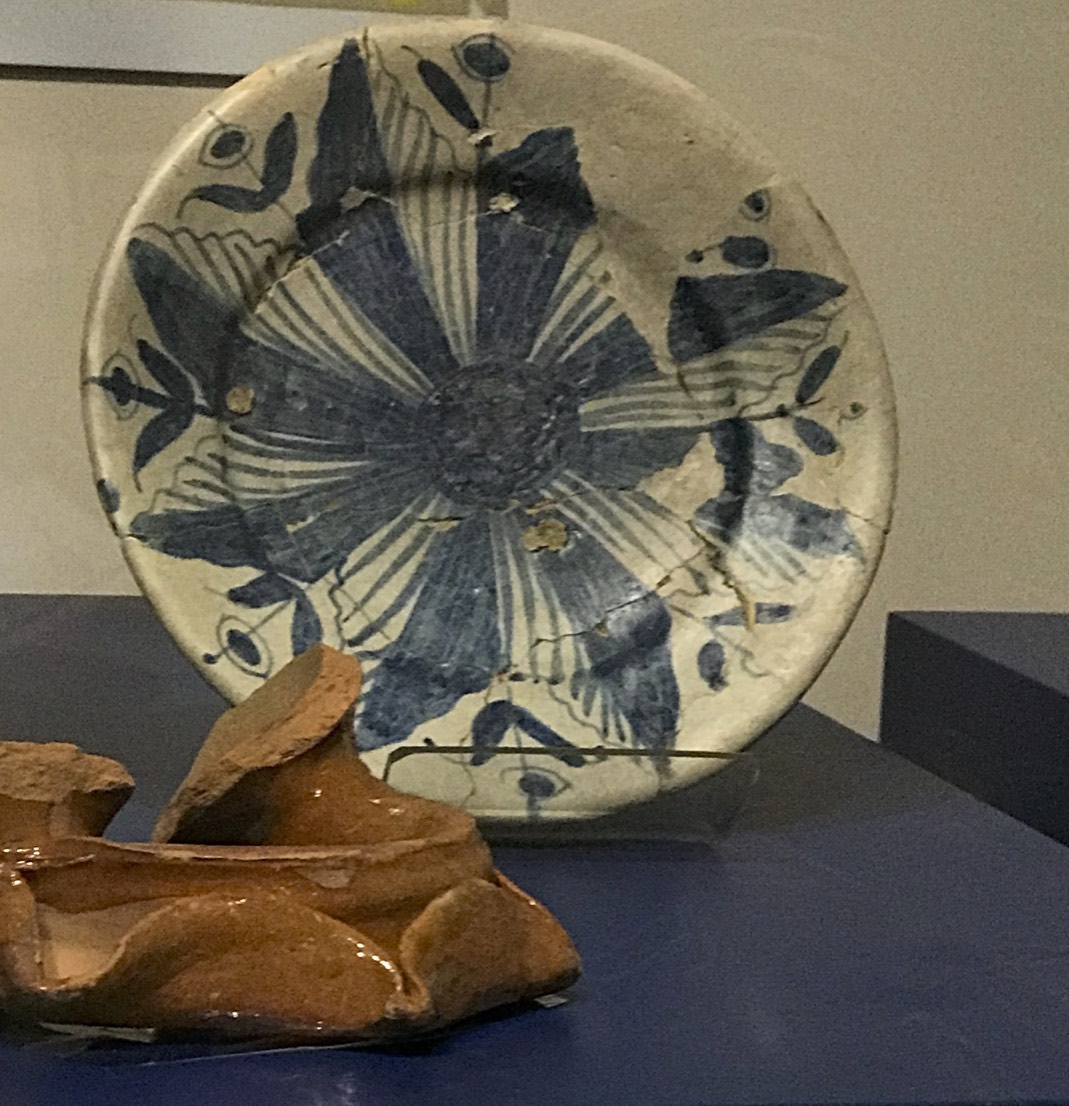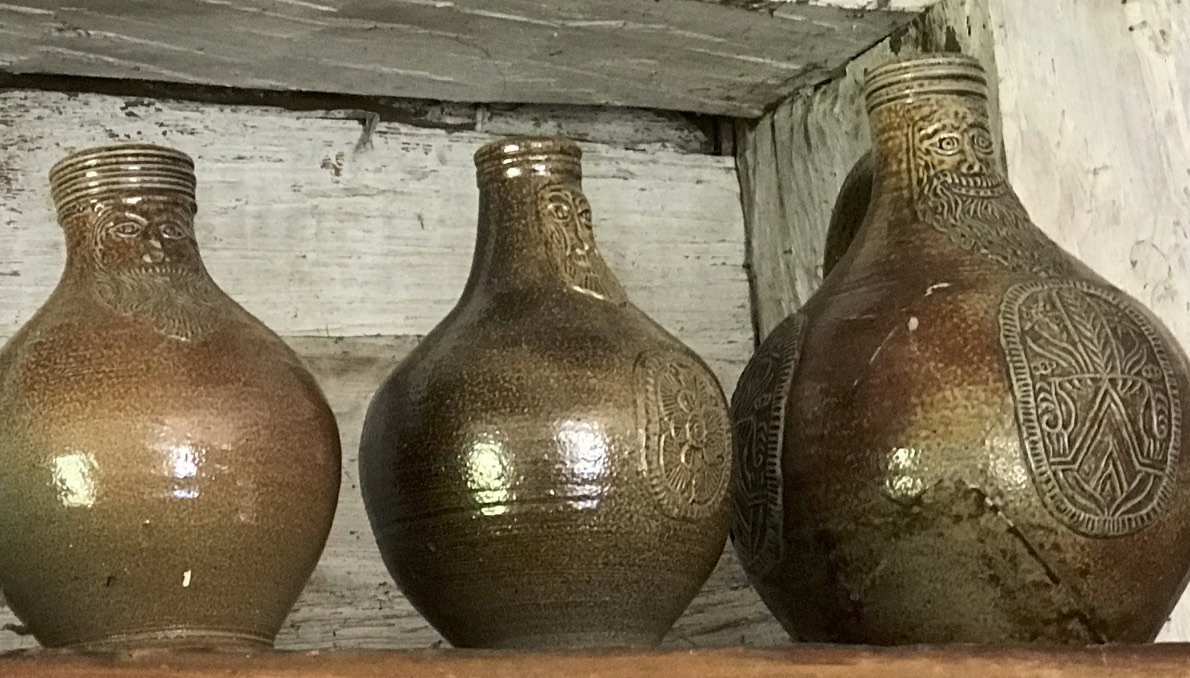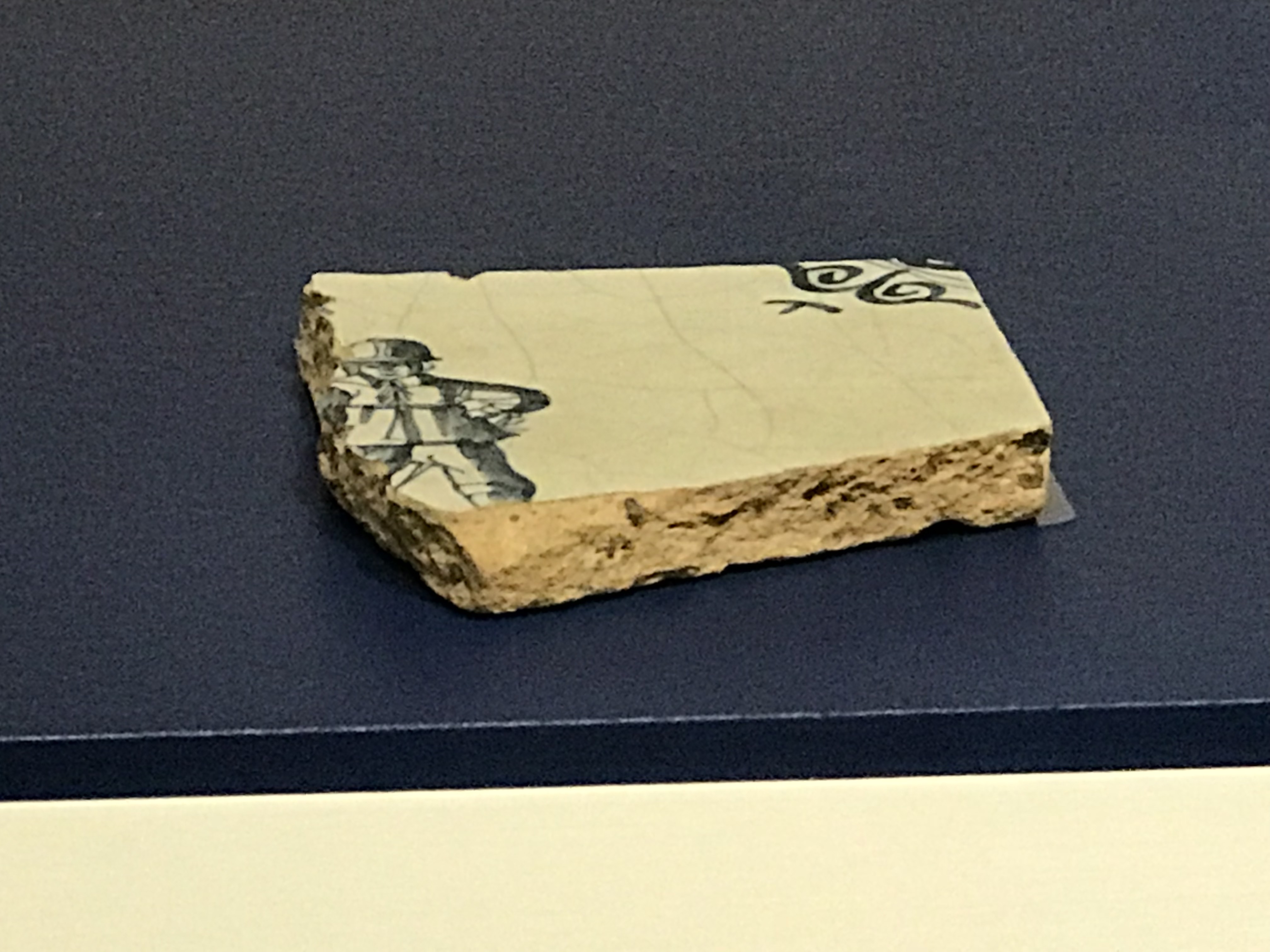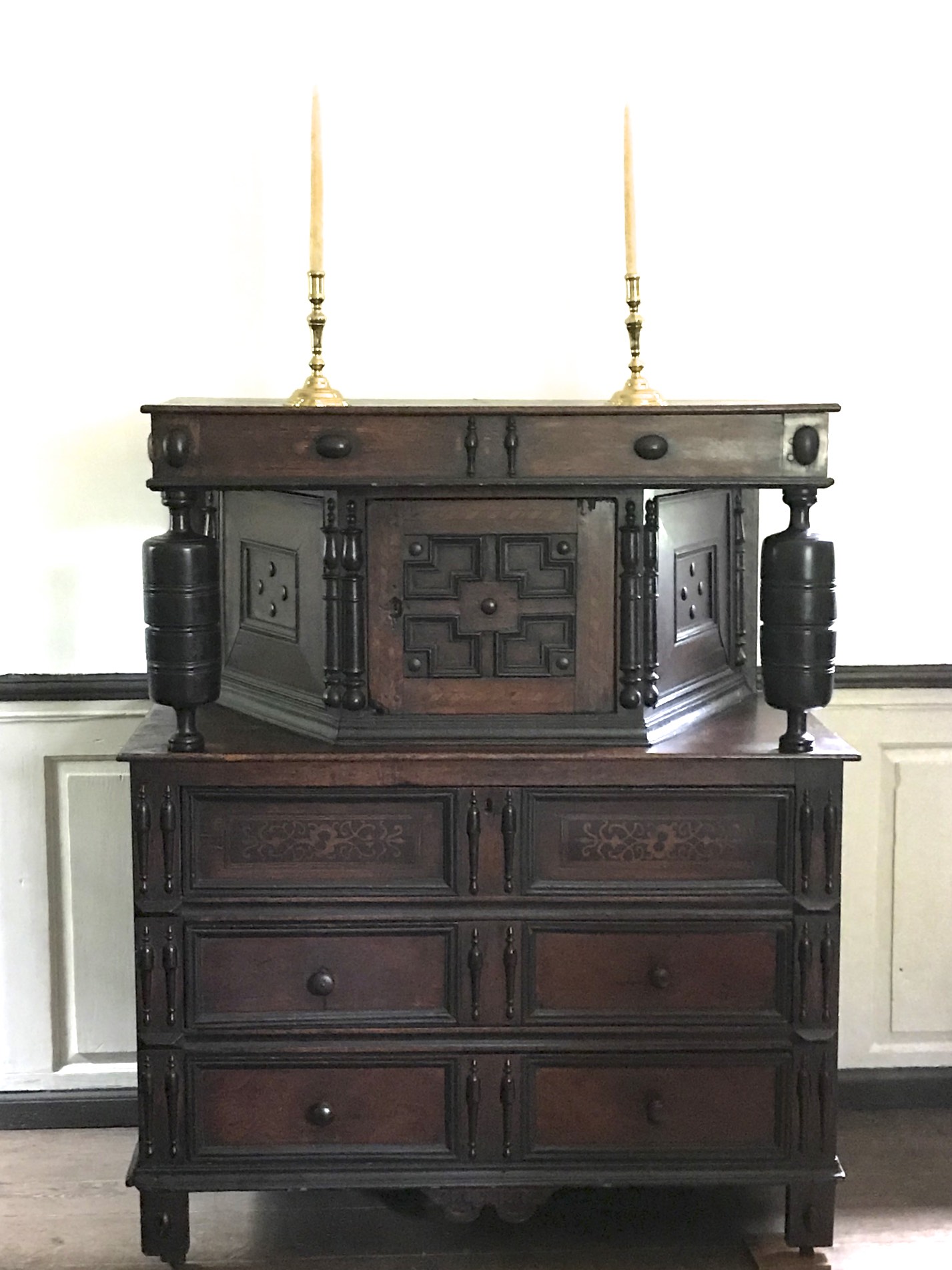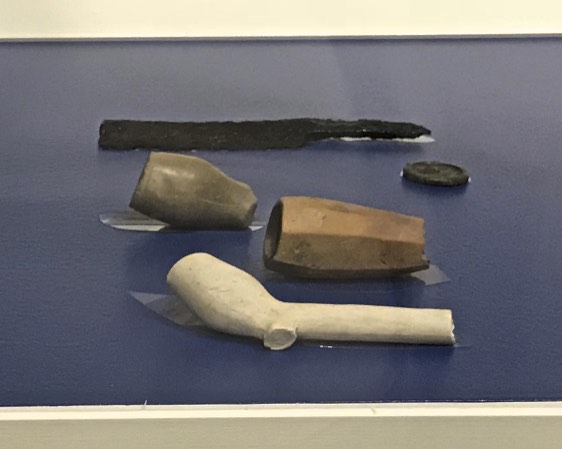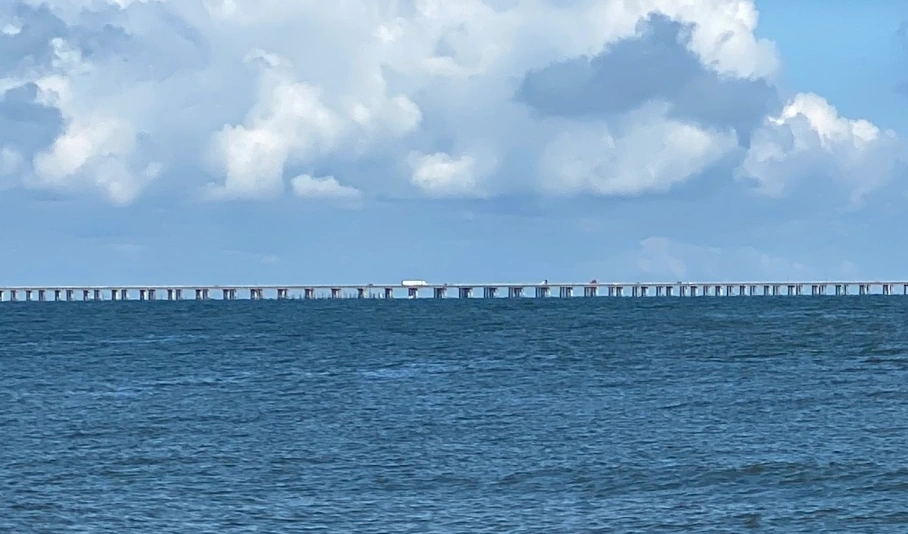
The first known mention of Francis Yeardley in Lower Norfolk County (later named Princess Anne, then Virginia Beach) was in June 1647. As noted in the prior post, Francis and his older brother Argoll, sons of Gov. George Yeardley, had settled in Accomack (later called Northampton County) on the Eastern Shore (Chesapeake Penninsula). Argoll had inherited their father’s lands, been appointed to the Governor’s Council, married, avoided the plague, and was enjoying a prosperous life. While Francis had acquired 3,000 acres by transporting 60 headrights, he was still a bachelor and not as successful as his brother. (See Interwoven Lives: Part I)
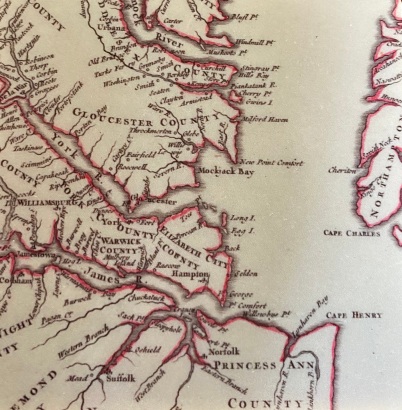 Eastern Shore and Lower Norfolk residents often shared merchant ties and attitudes from their common “outlier” status in the Virginia Colony. As the Thorowgood’s Lower Norfolk lands were close to Cape Henry at the entrance to the Chesapeake Bay, there would have been much shipping passing by, and it was a straight path from Hungars and Nassawadox Creek where the Yeardleys lived to the Thorowgood lands on the Lynnhaven Bay/River. So whether Francis came there for business or was looking for additional land and opportunities, he and several local acquaintances spent the night of June 10, 1647 at the house of the twice widowed Sarah Thorowgood Gookin.
Eastern Shore and Lower Norfolk residents often shared merchant ties and attitudes from their common “outlier” status in the Virginia Colony. As the Thorowgood’s Lower Norfolk lands were close to Cape Henry at the entrance to the Chesapeake Bay, there would have been much shipping passing by, and it was a straight path from Hungars and Nassawadox Creek where the Yeardleys lived to the Thorowgood lands on the Lynnhaven Bay/River. So whether Francis came there for business or was looking for additional land and opportunities, he and several local acquaintances spent the night of June 10, 1647 at the house of the twice widowed Sarah Thorowgood Gookin.

An Unexpected Death
In a court deposition on June 12, Francis Yeardley stated, “Mr. Peregrine Bland being at the house of Mrs. Sarah Gookin in Lynhaven, broke his fast …in company of me and others and fed heartily…and drinking in the interim moderately…till his occasions calling him to go with Mr. Eyres and Mr. Hall, Chyrurgeon (surgeon).” Francis encouraged him to wait until the heat of the day had passed, but Bland proceeded on. Mr. Eyres went to check on him and discovered Bland had fallen asleep in a “barne fort” on the way. When Francis returned to check on him, he found Mr. Bland “lying on his right side, his arms under his head, dead, and purging at the mouth frothy blood.” From the inquest, it was determined there was no foul play, and, thus, their hostess, Sarah Gookin, was spared an appearance in court. [1]
Some have used this passage to conclude that Sarah ran a tavern on her property at which these gentlemen were staying. However, it was expected hospitality to provide food and shelter for travelers in those days, and these were notable guests. Licensed ordinaries (taverns) existed in Lower Norfolk County, and that very year the county court granted licenses to two individuals. None were to Sarah Gookin. [2]

Francis and Sarah had frequent involvement with the Lower Norfolk County Court over more than a decade, but there are no records of licensing, taxing, debts, sales, shipping, disputes, or gatherings for an ordinary connected with the Thorowgoods, Gookins, or Yeardleys . The existence of Gookin’s Landing and the building of a malt house (to produce malted beer) are evidence of smart businesses, but not proof of a tavern. The ceramics and artifacts found during the archaeological excavation of the Thorowgood’s original house site are expensive wares, not the type or quantity expected at a tavern site. Furthermore, all the sworn depositions from this incident clearly refer to the guests staying at Mrs. Gookin’s “house,” not another structure. (See Knives, Forks, and Silver Spoons: The Material Culture (and Jewels) of Sarah Offley Thorowgood Gookin Yeardley in 17th Century Virginia )

It was more than a century later during the Revolutionary era that there were references to a Pleasure House tavern in the Thorowgood area. It was even noted on a map when Benedict Arnold was commanding British troops in the area. That tavern burned in the War of 1812. [3]
An Unexpected Marriage
Whether the visit by Francis Yeardley was the start or the continuation of an ongoing courtship, he wooed Sarah Offley Thorowgood Gookin, and they were married within six months . They then lived on Sarah’s estate in Lower Norfolk County. That next year Yeardley patented additional adjoining lands based on transporting more headrights: 20 English, 7 Africans, and Simon, the Turk. [4]

This marriage likely surprised many. Francis was more than 10 years younger than Sarah.* There were obvious advantages for Francis, but what enticement was there for level-headed, wealthy Sarah? Sarah had enjoyed the legal advantages of being a “feme sole” for four years after the death of her second husband and had managed the estate well. Yet, she was also raising 5 children, and her daughters were coming near age for their own marriages. In addition, Sarah was locked in a dispute with the Lower Norfolk justices over the accounting of her children’s inheritances. Was she tiring of the business responsibilities or lonely for companionship or looking for a way to expand and enhance her social experiences and the status of her children? Their marriage seemed to be one of mutual convenience, but there must also have been some spark that drew these two dynamic personalities together, as there were likely other viable suitors. Smart Sarah, though, had learned from the example of Francis’ mother, Lady Temperance Yeardley, and set up a pre-nuptial arrangement to protect her finances before her third marriage. [5] (See The Fascinating and Formidable Sarah Offley Thorowgood Gookin Yeardley of 17th Century Virginia)
The Custis Clan from Rotterdam
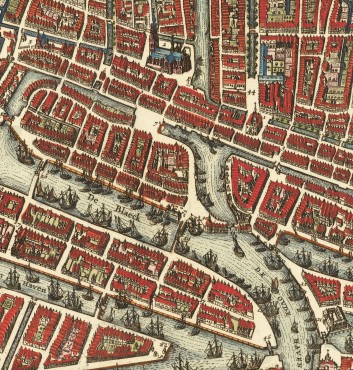
Argoll Yeardley’s life was also changing. Unfortunately, his wife Frances died around 1648, leaving him alone with their young children: Rose, Frances, and Argoll II. That following year, Argoll accompanied his tobacco shipment to Rotterdam and returned, perhaps unexpectedly, with their new stepmother, Ann Custis. It was an era of economic ties and competition between England and Holland, and numerous English merchants, such as Ann’s parents, Henry and Joan Custis, had moved to the cosmopolitan trade center of Rotterdam. In addition to their cloth business, Henry and Joan established St. John’s Head, a Rotterdam inn, that was popular with English merchants and ex-patriots. The Custises would have hosted many eligible and wealthy merchants, so we do not know what set Argoll apart that Ann should agree to leave her comfortable home for the challenges of the Eastern Shore. As with Sarah Offley’s marriage to Adam Thorowgood, Ann must have had a courageous and adventuresome spirit. [6]
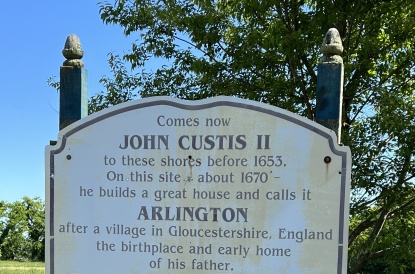 Ann’s acceptance of the marriage proposal brought the Custis family to Virginia. Her uncle, John Custis I, may have accompanied them or arrived shortly thereafter. Although John I conducted business, acquired property, and made periodic visits, he never settled there. However, Ann and Argoll Yeardley enticed her brothers John Custis II, William II, and Joseph, to join them, bringing a Custis dynasty to the New World. John II and William II who were born in Holland, though to English parents, were not naturalized by Act of Assembly until April 1658 which then allowed them to purchase land and hold office “as if they had been Englishmen born.” A woman’s citizenship was that of her husband. [7]
Ann’s acceptance of the marriage proposal brought the Custis family to Virginia. Her uncle, John Custis I, may have accompanied them or arrived shortly thereafter. Although John I conducted business, acquired property, and made periodic visits, he never settled there. However, Ann and Argoll Yeardley enticed her brothers John Custis II, William II, and Joseph, to join them, bringing a Custis dynasty to the New World. John II and William II who were born in Holland, though to English parents, were not naturalized by Act of Assembly until April 1658 which then allowed them to purchase land and hold office “as if they had been Englishmen born.” A woman’s citizenship was that of her husband. [7]
An Unexpected Guest
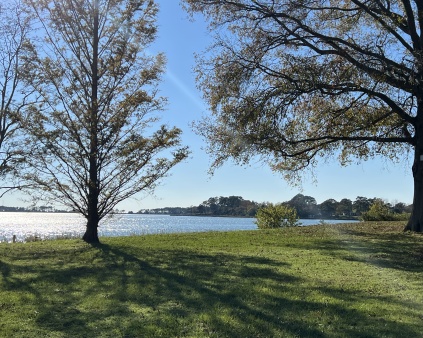
In 1650, Colonel Henry Norwood on his journey from England found himself stranded on the Eastern Shore. In his journal, he related that when he approached Argoll and Ann Yeardley, he was warmly received, having known Ann from when she was a child and her father who “kept a victualling house in that town, lived in good repute, and was the general host of our nation there.” Colonel Norwood said “I was received and caressed more like a domestic and near relation than a man in misery and a stranger. I stayed there for a passage over the bay, about ten days, welcomed and feasted not only by the esquire and his wife, but by many neighbors that were not too remote.” [8]
Sadly, the Yeardley’s house that provided such a welcome burned in 1651. However, we know from Argoll’s 1655 inventory that their next house was well furnished and had at least a hall chamber, a parlor chamber, a hall, two garrets, a kitchen, and a room over the kitchen as well as a dairy. Argoll and Ann Yeardley were living comfortably on the Eastern Shore and had the added joy of the birth of two sons, Edmund and Henry. Unfortunately, neither of them would have issue. [9]

Civil War Strife in Virginia
Meanwhile, England was being torn apart by Civil War. Gov. Berkeley, with whom Argoll served on the Council, maintained his loyalty to King Charles I and his son, Charles II, even after the king was beheaded in 1649. As noted in a prior post, Gov. Berkeley had actively persecuted the Virginia Puritans in Upper and Lower Norfolk, resulting in many moving to Maryland, and he had refused to comply with Parliament’s orders. On the Eastern Shore and elsewhere, several spoke out against the King which led the Assembly to prohibit speech in favor of the regicide, the change to Parliamentary governance, or in challenge to local government authority. At times, tensions flared. [10] (See Religious Tolerance/ Intolerance in 17th c Virginia)
 Shortly after the English Civil War began, Richard Ingle, the master of the ship Reformation and an avowed supporter of the parliamentary cause, got into an argument with Francis Yeardley about the King and Parliament while he was docked on the Eastern Shore. Argoll, who was also on board, attempted to calm them. However, Ingle grabbed a poleax and a cutlass and ordered all Virginians off his ship. As a Councillor and the Commander of the Eastern Shore, Argoll responded, “I arrest you in the King’s name.” Ingle replied, “If you had arrested me in the King and Parliaments name I would have obeyed it for so it is now.” He then forced the Virginians, including Francis and Argoll, to leave his ship and sailed to Maryland, boasting of his defiance of Yeardley. However, months later, Argoll forgave Inge “of and from all manner of debts, suits, and controversies.”[11]
Shortly after the English Civil War began, Richard Ingle, the master of the ship Reformation and an avowed supporter of the parliamentary cause, got into an argument with Francis Yeardley about the King and Parliament while he was docked on the Eastern Shore. Argoll, who was also on board, attempted to calm them. However, Ingle grabbed a poleax and a cutlass and ordered all Virginians off his ship. As a Councillor and the Commander of the Eastern Shore, Argoll responded, “I arrest you in the King’s name.” Ingle replied, “If you had arrested me in the King and Parliaments name I would have obeyed it for so it is now.” He then forced the Virginians, including Francis and Argoll, to leave his ship and sailed to Maryland, boasting of his defiance of Yeardley. However, months later, Argoll forgave Inge “of and from all manner of debts, suits, and controversies.”[11]
Gov. Berkeley was finally forced to resign and surrender when ships with Parliamentary forces arrived in Virginia in 1652. Argoll Yeadley was appointed to the new Council of Richard Bennett, the Commonwealth’s Governor, and was tasked with obtaining the signatures of the Northampton residents who had to swear their allegiance to the Commonwealth. Whatever the citizens may have felt, this was done without incident.[12]

Sisters-in-Law: Ann & Sarah
Despite their age differences, Ann Custis and Sarah Offley Thorowgood Gookin had married the Yeardley brothers within two years of each other and became sisters-in-law. Their husbands continued to be involved in each other’s ventures and drew the Custis brothers into their affairs. But did Sarah and Ann ever meet or visit or write each other? The records are silent, but these two dynamic women surely knew of and influenced each other.
 They likewise shared common grief in losing their Yeardley husbands a year apart: Argoll in 1655 and Francis in 1656. We do not know the circumstances of their deaths, but both died unexpectedly without wills. Did Sarah and Ann confide concerns about their husbands’ health or exchange condolences? Sarah died a year after Francis. They had not had any children together. [13]
They likewise shared common grief in losing their Yeardley husbands a year apart: Argoll in 1655 and Francis in 1656. We do not know the circumstances of their deaths, but both died unexpectedly without wills. Did Sarah and Ann confide concerns about their husbands’ health or exchange condolences? Sarah died a year after Francis. They had not had any children together. [13]
Argoll’s Insufficient Estate
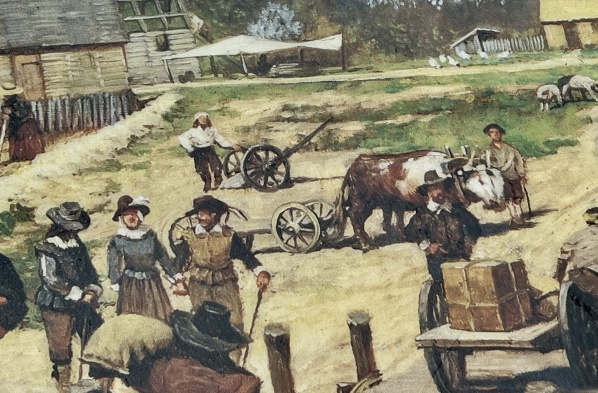 Ann was appointed the executrix of Argoll’s estate when he died intestate. Settling his estate was complex. The inventory and appraisal of the estate on October 29, 1655 revealed that Argoll had 10 ewes, 16 cows, and 3 horses; 2 indentured servants with 3 months of service left in their contracts; and 2 Negro men, 2 Negro women (their wives), and 4 Negro children, only one of which was to be freed at adulthood (see prior post), providing further evidence that their Africans were enslaved, not indentured. The Yeardleys had lived comfortably with cupboards, beds, linens, a large Dutch looking glass (mirror), books, cookware, pewter, silver plate, a small boat, and more. Argoll’s estate was appraised at the equivalent of 41,269 pounds of tobacco which should have been adequate to pay off the usual debts.[14]
Ann was appointed the executrix of Argoll’s estate when he died intestate. Settling his estate was complex. The inventory and appraisal of the estate on October 29, 1655 revealed that Argoll had 10 ewes, 16 cows, and 3 horses; 2 indentured servants with 3 months of service left in their contracts; and 2 Negro men, 2 Negro women (their wives), and 4 Negro children, only one of which was to be freed at adulthood (see prior post), providing further evidence that their Africans were enslaved, not indentured. The Yeardleys had lived comfortably with cupboards, beds, linens, a large Dutch looking glass (mirror), books, cookware, pewter, silver plate, a small boat, and more. Argoll’s estate was appraised at the equivalent of 41,269 pounds of tobacco which should have been adequate to pay off the usual debts.[14]
 However, growers of tobacco and trade merchants lived in a world of credit, and their cash flow was often in flux. At the moment of Argoll’s unexpected death, he had extended his credit beyond his means, for Ann reported to the court in November 1655 that she had paid out “a considerable sum of tobacco beyond assets to the creditors of her dead husband.” Ann Yeardley was ordered to find what she could to pay debts, but was granted a Quietus Est or termination of remaining debts by the court. Fortunately, real estate was not included in the assessment, so Argoll II still inherited his father’s property, and Ann received her widow’s dower interest which she released to Argol II when he agreed to deed land to her sons (his stepbrothers). [ 15]
However, growers of tobacco and trade merchants lived in a world of credit, and their cash flow was often in flux. At the moment of Argoll’s unexpected death, he had extended his credit beyond his means, for Ann reported to the court in November 1655 that she had paid out “a considerable sum of tobacco beyond assets to the creditors of her dead husband.” Ann Yeardley was ordered to find what she could to pay debts, but was granted a Quietus Est or termination of remaining debts by the court. Fortunately, real estate was not included in the assessment, so Argoll II still inherited his father’s property, and Ann received her widow’s dower interest which she released to Argol II when he agreed to deed land to her sons (his stepbrothers). [ 15]
Conspiracy? Follow the Money
How did a well respected gentleman such as Argoll end up in such a quandary? Some of his money might have been spent on the joint project initiated by his brother Francis to establish relations and trade with Roanoke tribes in North Carolina which Francis wrote about in 1654. The amount Argoll owed his notable Eastern Shore neighbors was only 11,604 pounds of tobacco which was able to be paid off. However, more than twice that (28,874 lbs. tobacco and 677 Dutch Guilders) was claimed by the Custis family. How could Argoll, who had hosted the emigrant Custises and provided them land, servants, and cattle, ended up owing them so much in just 5 years? John II, who could not yet purchase land, had even been leasing a plot from Argoll since 1653. [16]

On Christmas Day, 1654, Ann’s older brother, Edmund Custis III, was arrested in London with Henry Norwood and other co-conspirators in a plot to supply weapons for an anticipated revolt against Cromwell and for the restoration of the monarchy. The agents of John Thurloe, the Secretary of State and spymaster under Cromwell, discovered “5 chests and 2 trunks of arms now found at his (Edmund’s) house.”
 According to one conspirator’s confession, the plan also included hiring a ship of one of Edmund’s brothers (likely Robert who was a shipmaster) to smuggle additional arms into England. Edmund claimed that the arms he had in the house were to send to Virginia, but the Commonwealth Assembly had not requested them. Edmund was sent to prison with Norwood. After Captain Norwood had innocently stayed at the Yeardley’s home in 1650, he had gone to Jamestown and may have initiated the plot in conjunction with Governor Berkeley. Assets of 1,000 pounds from Governor Berkeley were subsequently funneled to Edmund Custis.[17]
According to one conspirator’s confession, the plan also included hiring a ship of one of Edmund’s brothers (likely Robert who was a shipmaster) to smuggle additional arms into England. Edmund claimed that the arms he had in the house were to send to Virginia, but the Commonwealth Assembly had not requested them. Edmund was sent to prison with Norwood. After Captain Norwood had innocently stayed at the Yeardley’s home in 1650, he had gone to Jamestown and may have initiated the plot in conjunction with Governor Berkeley. Assets of 1,000 pounds from Governor Berkeley were subsequently funneled to Edmund Custis.[17]

The claims made against Argoll’s estate which included the 677 Guilders and 10,383 pounds of tobacco were due to this Edmund Custis, called innocently a London merchant, and his brother Joseph, who may have helped handle things while Edmund was imprisoned. John Custis, Sr. (Ann’s uncle) claimed he was owed 14,227 pounds, and John Custis II claimed 4,154 pounds based on goods delivered by his brother Robert to Argoll Yeardley in Virginia. For all the money owed to the Custises, there were no equivalent goods accounted for in the inventory or evidence of services rendered or shipments lost or in process. Perhaps the Custises had contributed when Argoll had to rebuild his burnt house several years before, but even that and the generally “old” furnishings in his household inventory would not equal what he owned.
The claims were made by the Custises who lived at least part-time in Virginia, avoiding review by an English court. Despite Argoll’s oath of allegiance to the Commonwealth, had some of his wealth gone to the purchasing of arms or the funding of a planned rebellion? Or had Argoll unsuccessfully invested in some of Edmund III’s shipping ventures, made even more risky during the First Anglo-Dutch War of 1652-1654? Knowing their sister/ niece’s situation, why did Ann’s family not forgive some of her debt? Edmund would later forgive John II a debt. Ann must have had a difficult and anxious year in 1655: her brother in prison, her husband dead, and her wealth gone. Ann’s brother, John Custis II, did assist her in settling the estate and handling the dwindled assets of her children. [18]
Married, Again
Ann Custis Yeardley soon remarried, as was common with Virginia widows. Not to be confused with the ancient planter John Wilcox who had also lived on the Eastern Shore, Ann’s second husband, John Wilcox/ Wilcocks served as a representative to the Assembly in 1658 and acted as an attorney for other settlers, served on a jury, and helped resolve disputes before the courts. Wilcocks owned land in the area known today as Pear Plain across from Argoll Yeardley on Hungars Creek. A child William was born to them in 1661, but unfortunately did not live long after his baptism. [19] (See The Widow Thorowgood and the Power and Perplexities of 17th Century Widows in Virginia)
The Face Worth 1,000 Pounds
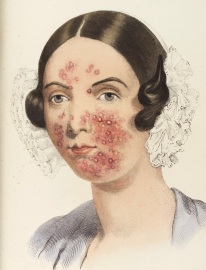
Jenean Hall uncovered from the Northampton Court records the story of John Wilcocks’ extraordinary concern for his wife. Ann Custis Yeardley Wilcocks developed unspecified sores on her face which led her husband to make an agreement with John Rhoads, a chirugeon (surgeon) then on the Eastern Shore, to pay 1,000 pounds of tobacco for his “paines and means” if Rhoads could provide a long term cure of her sores, lasting at least from spring through fall. Wilcocks later increased the offer to 2,000 pounds. This was a substantial offer. Rhoads expressed some hesitancy on his choice of treatments because Ann was pregnant at the time, but took the deal.
However, Wilcocks did not pay Rhoads that sum. Rhoads sued Wilcocks for payment in April 1662, but the Northampton court was not impressed by the treatment or improvement, for the justices found that the provision of his “diets” (meals–maybe room and board?) was “sufficient satisfaction for the medicines administered.” In addition, Rhoads had to pay the court costs. Unfortunately, in the following weeks, John Wilcocks became seriously ill and died, leaving Ann pregnant and widowed for the second time. Perhaps hoping to collect more from the estate of John Wilcocks, Rhoads again petitioned the court in October for payment for Ann’s treatment. The court, however, rejected it as it was the same plea and there was “no further cause of suit appearing, neither the cure manifested nor any other application used.” Once again, Rhoads had to pay court costs. [20]
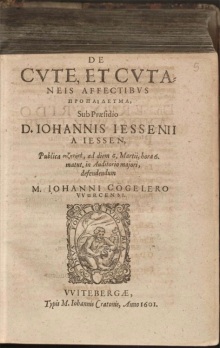 Sadly, it seems Ann was not cured at the time, but many questions remain unanswered. Was this a case of exorbitant doctor fees or lofty claims of a cure that could not be provided? A gesture of love or a demand for vanity? What sort of sores were these? It was likely more than a case of usual acne or hormonal imbalance, as Ann had borne children before. Perhaps, acne had worsened with streptococcus or staphylococcus bacteria. The sores did not sound like pox marks which would not have had seasonal variation.
Sadly, it seems Ann was not cured at the time, but many questions remain unanswered. Was this a case of exorbitant doctor fees or lofty claims of a cure that could not be provided? A gesture of love or a demand for vanity? What sort of sores were these? It was likely more than a case of usual acne or hormonal imbalance, as Ann had borne children before. Perhaps, acne had worsened with streptococcus or staphylococcus bacteria. The sores did not sound like pox marks which would not have had seasonal variation.
It had only been a few decades since the physician Jan Jessen had published his famous work On Skin and Skin Disorders, so there was still much uncertainty on the nature of human skin and the causes and treatment of skin problems. Lancing/ bleeding/leeches, face plasters, biologic treatments like honey or camphor oil, herbal applications like aloe or onion, more dangerous chemical applications of mercury, lead, or silver, or simply the control of one’s diet were all in practice. While understanding of diseases and treatments has changed over the centuries, the story of a loving husband’s support for his wife’s struggle for a cure still resonates today. [21]
Widowed, Again
 In May 1662 just prior to his death, John Wilcocks prepared a will and shortly thereafter revised it. He left to his wife Ann his “whole estate real & personal lands and chattels during her natural life” which, on her decease, would go to their “child or children now in her womb.” But he was also inclusive of his stepsons, Henry and Edmond (Ann’s children with Argoll Yeardley), authorizing Ann to divide of his personal estate as inheritance for them as “to her shall seem fitting” and made them successively his heirs in case of the death of the child in the womb. He reminded his wife that he had “desired to be in some large measure helpful to the children or child of my brother Henry if he should have any.”
In May 1662 just prior to his death, John Wilcocks prepared a will and shortly thereafter revised it. He left to his wife Ann his “whole estate real & personal lands and chattels during her natural life” which, on her decease, would go to their “child or children now in her womb.” But he was also inclusive of his stepsons, Henry and Edmond (Ann’s children with Argoll Yeardley), authorizing Ann to divide of his personal estate as inheritance for them as “to her shall seem fitting” and made them successively his heirs in case of the death of the child in the womb. He reminded his wife that he had “desired to be in some large measure helpful to the children or child of my brother Henry if he should have any.”
In his codicil, he made it clear that “my beloved wife…shall solely and wholly enjoy my whole estate…giving no account of waste to any person.” He also specified that he forgave his brother any debts he owned him and designated that if there were a child of his brother, it would receive 200 acres and 6 cows. John Wilcocks was a generous man who clearly trusted his wife Ann, but unfortunately left no descendant to emulate him. There is circumstantial evidence, based mostly on land records, that Ann Custis Yeardley Wilcocks next married a younger man, John Luke, who lived with her on the Wilcocks property until her death. They had no children together. [22]
Legacies of the Ladies
 The Thorowgoods are rarely acknowledged in Eastern Shore history; yet as Francis’ wife, the powerful Sarah would have had some impact on affairs there. The Thorowgood genes and heritage infused the Eastern Shore through the marriage of her daughter Elizabeth Thorowgood to John Michaels, and thus to their Custis grandchildren. The Yeardley genes and heritage likewise came to Lower Norfolk through Argoll’s daughter Frances Yeardley II who married Adam Thorowgood II. The Thorowgood, Custis, and Yeardley women may not be the names that are usually remembered in history, but they played important roles in weaving the complex tapestry of the developing Virginia society.
The Thorowgoods are rarely acknowledged in Eastern Shore history; yet as Francis’ wife, the powerful Sarah would have had some impact on affairs there. The Thorowgood genes and heritage infused the Eastern Shore through the marriage of her daughter Elizabeth Thorowgood to John Michaels, and thus to their Custis grandchildren. The Yeardley genes and heritage likewise came to Lower Norfolk through Argoll’s daughter Frances Yeardley II who married Adam Thorowgood II. The Thorowgood, Custis, and Yeardley women may not be the names that are usually remembered in history, but they played important roles in weaving the complex tapestry of the developing Virginia society.
* There is question regarding the birth years of Argoll and Francis Yeardley. The 1624 Muster recorded Argoll as 4; Frances as 1; and their older sister as 6 years old while living in James City with their parents. A birth year of 1619/20 for Argoll meant he would have been unusually young when he married, inherited his father’s lands, and was placed on the Council. Likewise, Frances would have been young to receive a patent for bringing headrights. Disparities in the ages listed for other individuals in the Muster have raised questions as to what reference point was used, i.e. Adam Thorowgood was listed as 18, although he was 20 in 1624. In depositions given in 1630 for the suit Yardley v. Rossingham (C24/561 Pt2/136), William Claiborne stated “the eldest son known by Argall Yardley… being of the age of some thirteen years or thereabouts and the second of the age of some twelve years.” Susanna Hall stated in her deposition that the daughter was “some 16 years of age or thereabouts; the eldest son some 14 years old, and the youngest some 12 years old.” This would adjust Argoll’s birthdate to about 1616 or 1617 and Francis’ birthdate to around 1618 or 1619. The adjusted dates seem more reasonable. [See footnote 5]
Next Post: Dutch Merchants in the Chesapeake and Thorowgood Brides
Special Thanks to Jenean Hall, Eastern Shore historian and author, and Jorja Jean, Virginia Beach historian and researcher, for their insights and assistance.
Footnotes:
- Walter, Alice Granberry, Lower Norfolk County Virginia, Court Records: Book “B” 1646-1651/2 (Baltimore: Clearfield, 2009), 40-41. Turner, Florence Kimberly, Gateway to the New World: A History of Princess Anne County Virginia, 1607-1824 (Easley, South Carolina: Southern Historical Press, 1984), 55.
- Walter, Book “B,” 59-60. Pieczynski, Christopher, The Pleasure House: A Research Study Submitted to the Virginia Beach Historic Preservation Commission (June 30, 2020). Accessed 4/20/2023 online at https://www.vb.gov.com
- Luccketti, Nicholas M., Robert Haas and Mathew Laird, Archaeological Assessment of the Chesopean Site, Virginia Beach, Virginia (Williamsburg, VA: James River Institute for Archaeology, Inc, December 2006), 6-7, 28-30. Outlaw, Merry and Bly Bogley (cataloguers), “Site Number 44VB48: Thorowgood or Chesopean, Virginia Beach,” Archaeological Specimen Catalog for The Virginia Research Center for Archaeology, 1980.
- Walter, Book “B,” 53 (53a), 49 ( 50), 58-59 (60), 74 (76a), 81 ( 90a).
- Morgan, Edmund S., American Slavery, American Freedom (New York: W.W. Norton, 1975), 166-167. Hotten, John Camden, The Original Lists of Persons of Quality (Berryville, Virginia: Virginia Book Company, 1980; originally published in London, 1874), 123, 222. Dorman, John Frederick, Adventurers of Purse and Person Virginia 1607-1624/5, v. 3, 4th edition (Baltimore: Genealogical Publishing Co, Inc., 2007), 865-866. McCarthy, Martha W., Virginia Immigrants and Adventurers, 1607-1635 (Baltimore: Genealogical Publishing Co., 2007), 775. Nugent, Nell Marion, Cavaliers and Pioneers: Abstracts of Virginia Land Patents and Grants 1623-1666, v. 1 (Baltimore: Genealogical Publishing Co., 1979), 81. Currer-Briggs, Noel, “Parentage and Ancestry of Sir George Yeardley and Temperance Flowerdew,” National Genealogical Society Quarterly, 66, 17-28.
- Dorman, 866. Whitelaw, Ralph T., Virginia’s Eastern Shore, v.1 (Richmond: Virginia Historical Society, 1950), 289. Lynch, James B., Jr, The Custis Chronicles: The Years of Migration (Camden, Maine: Picton Press, 1992), 36-37, 49-50.
- Lynch, 137-151, 159-160, 217. McCartney, Jamestown People to 1800 (Baltimore: Genealogical Publishing Company, 2012), 131-134.
- Lynch 137-138. Whitelaw, 289. Turman, Nora Miller, The Eastern Shore of Virginia 1603-1964, (Onancock, Virginia: The Eastern Shore News, Inc., 1964), 49-51.
- Whitelaw, 289. Dorman 866. Bruce, Philip Alexander, Economic History of Virginia in the Seventeenth Century (New York: The MacMillan Company, 1907), 157. Mackey, Howard and Marlene A. Groves, Northampton County Virginia Record Book: Orders, Deed, Wills 1654-1655, v. 5 (Rockport, Maine, Picton Press, 1999), 222-225.
- Perry, James R., The Formation of a Society on Virginia’s Eastern Shore, 1615-1655 (Chapel Hill: University of North Carolina Press, 1990), 209-210. Wise, Jennings Cropper, Ye Kingdome of Accawmacke or the Eastern Shore of Virginia in the Seventeenth Century (Richmond: The Bell Book and Stationary Co., 1911), 133-136.
- Perry 207. Hall, Jenean, unpublished papers, 2023.
- Bond, Edward L., Damned Souls in a Tobacco Colony: Religion in Seventeenth Century Virginia (Macon, GA: Mercer University Press, 2000), 158-159. Neill, Edward D. Virginia Carolorum: The Colony Under the Rule of Charles the First and Second (Albany:Joel Munsell’s and Sons, 1886, reprinted by Scholar Select), 217-225.
- Dorman, 328, 865-866.
- Turner, Nora MIller and Mark C. Lewis, “Inventory of the Estate of Argoll Yeardley of Northampton County, Virginia in 1655,” The Virginia Magazine of History and Biography, 70:4 (October 1962), 410-419. Whitelaw, 290.
- Mackey, Howard and Marllene A. Groves, Northampton County Virginia Record Book: Deeds, Wills & Etc. 1665-1657, v. 6 and 7-8 (Rockport, Maine: Picton Press, 2002), 37-38.
- Mackey, v.6 and 7-8, p. 9-10, 21-22. Lynch, 160. Salley, Alexander S., Jr., (editor), Narratives of Early Carolina 1650-1708 (New York: Charles Scribner’s Sons, 1911. Facsimile copy by Elibron Classics, 2005), 25-29. “Money in the 17th century Netherlands,” accessed online 7/3/23 at Dutch money
- Lynch, 63-66, 106-107. Harrison, Fairfax, “Henry Norwood (1615-1689),” The Virginia Magazine of History and Biography, 33:1 (January 1925), 6-7. “Henry Norwood,” wikipedia. Accessed online 7/3/23.
- Mackey, v.6 and 7-8, p. 9-10. Lynch, 58-59.
- McCartney, Jamestown, 446. Whitelaw, 412-413. Mackey, Howard and Candy McMahan Perry, NorthamptonCounty Virginia Record Book: Deeds, Wills & Etc 1637-1666, v. 7, (Rockport, Maine: Picton Press, 2002), 175-176. Lynch, 139. Hall, Jenean, unpublished papers, 2023.
- Mackey, Howard and Marlene A. Groves, Northampton Count Virginia Record Book: Court Cases 1637-1664, v.8 (Rockport, Maine: Picton Press, 2002), 228-229, 269-270. Hall, Jenean, unpuplished papers, 2023.
- Murphy H., Skin and Disease in Early Modern Medicine: Jan Jessen’s De cute, et cutaneis affectibus (1601). Bull Hist Med. 2020;94(2):179-214. doi: 10.1353/bhm.2020.0034. PMID: 33416551; PMCID: PMC7850318. Mahmood NF, Shipman AR. The age-old problem of acne. Int J Womens Dermatol. 2016 Dec 2;3(2):71-76. doi: 10.1016/j.ijwd.2016.11.002. PMID: 28560299; PMCID: PMC5440448.
- Lynch, 138-139, 224-225. Whitelaw, 412-413. Hall, Jenean, unpublished papers, 2023.

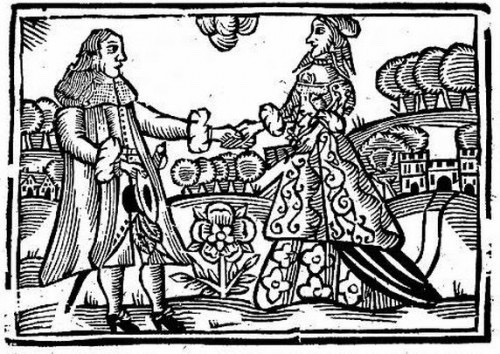
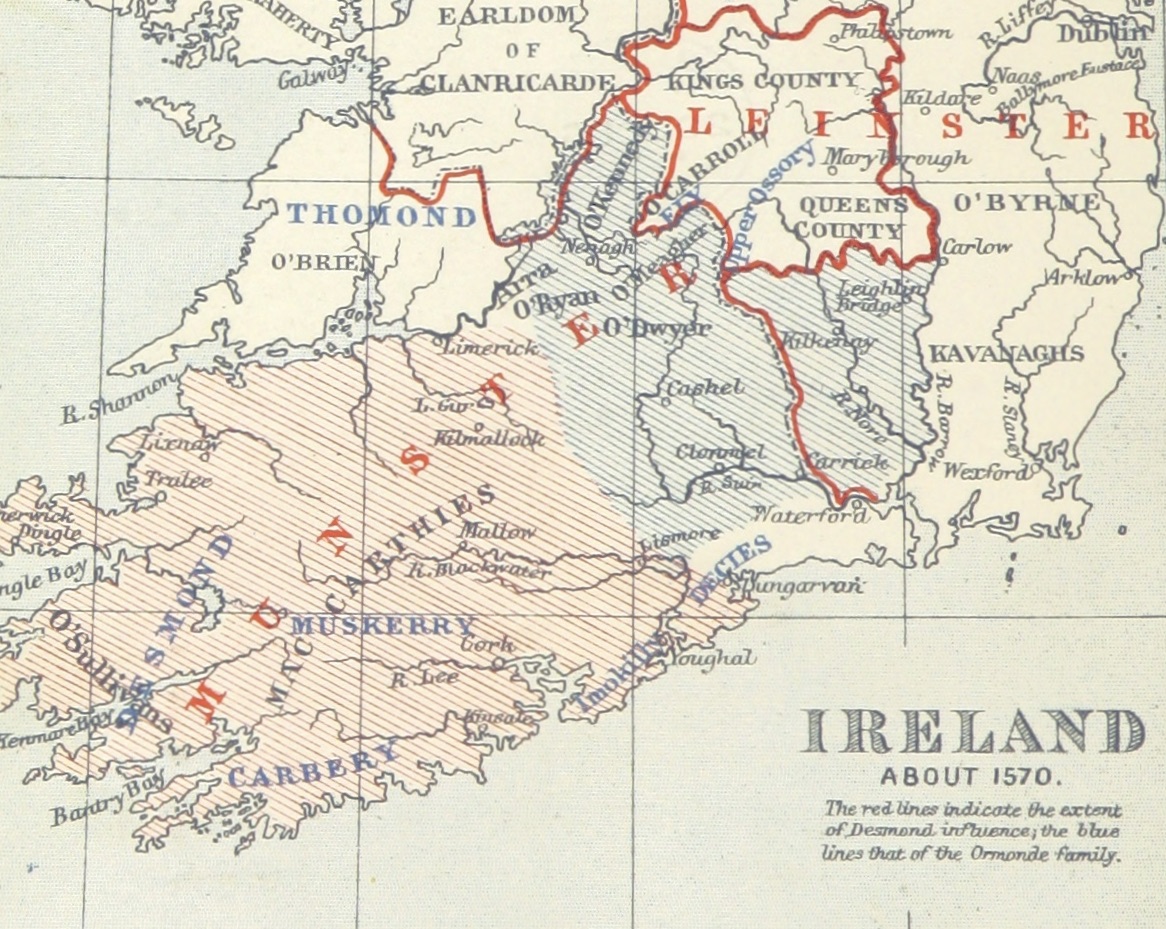


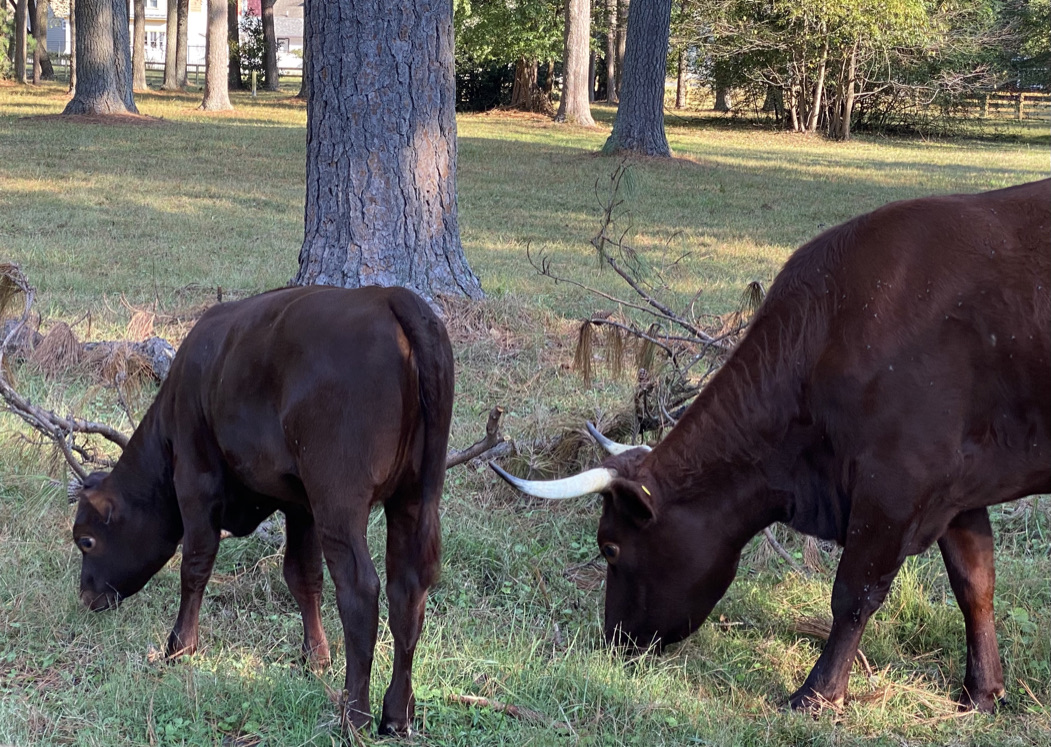 Likely inspired by them, Daniel Gookin Sr. had an approved proposal to bring cattle out of Ireland to Virginia by November 1620, and in July 1621, he asked the Council to be granted a plantation as large as was given to William Neuce. Daniel Gookin Sr. arrived in Virginia from Ireland in November 1621 on the Flying Harte to the acclaim of the Virginia Council:[5]
Likely inspired by them, Daniel Gookin Sr. had an approved proposal to bring cattle out of Ireland to Virginia by November 1620, and in July 1621, he asked the Council to be granted a plantation as large as was given to William Neuce. Daniel Gookin Sr. arrived in Virginia from Ireland in November 1621 on the Flying Harte to the acclaim of the Virginia Council:[5] 
 Good real estate often stays good real estate. The site that Daniel Gookin Sr. chose on the James River not far from the confluence with the Nansemond River is today covered by the Newport News shipyard (America’s largest industrial shipbuilder) and a terminus for the largest coal exporting site in the U.S. While nothing of Marie’s Mount remains to be found, a small window opened between 1928 and 1935 when a Newport News physician, Jerome Knowles, found a large exposed 17th century trash pit on the eroding banks of the James River in the area of Marie’s Mount. Dr. Knowles eventually donated the artifacts to Iver Noel Hume, the director of archaeology for Colonial Williamsburg, where the collection still resides. Dr. Hume noted the artifacts were from the 2nd quarter of the 17th century (the Gookin era) and stated there was “the finest group of Pisa marbled slipwares that I have seen or heard of from any other site.” The quantity and type of artifacts in this happenstance collection seemed to be in line with the presence of around 30-50 people at the Gookin site. [8]
Good real estate often stays good real estate. The site that Daniel Gookin Sr. chose on the James River not far from the confluence with the Nansemond River is today covered by the Newport News shipyard (America’s largest industrial shipbuilder) and a terminus for the largest coal exporting site in the U.S. While nothing of Marie’s Mount remains to be found, a small window opened between 1928 and 1935 when a Newport News physician, Jerome Knowles, found a large exposed 17th century trash pit on the eroding banks of the James River in the area of Marie’s Mount. Dr. Knowles eventually donated the artifacts to Iver Noel Hume, the director of archaeology for Colonial Williamsburg, where the collection still resides. Dr. Hume noted the artifacts were from the 2nd quarter of the 17th century (the Gookin era) and stated there was “the finest group of Pisa marbled slipwares that I have seen or heard of from any other site.” The quantity and type of artifacts in this happenstance collection seemed to be in line with the presence of around 30-50 people at the Gookin site. [8] 

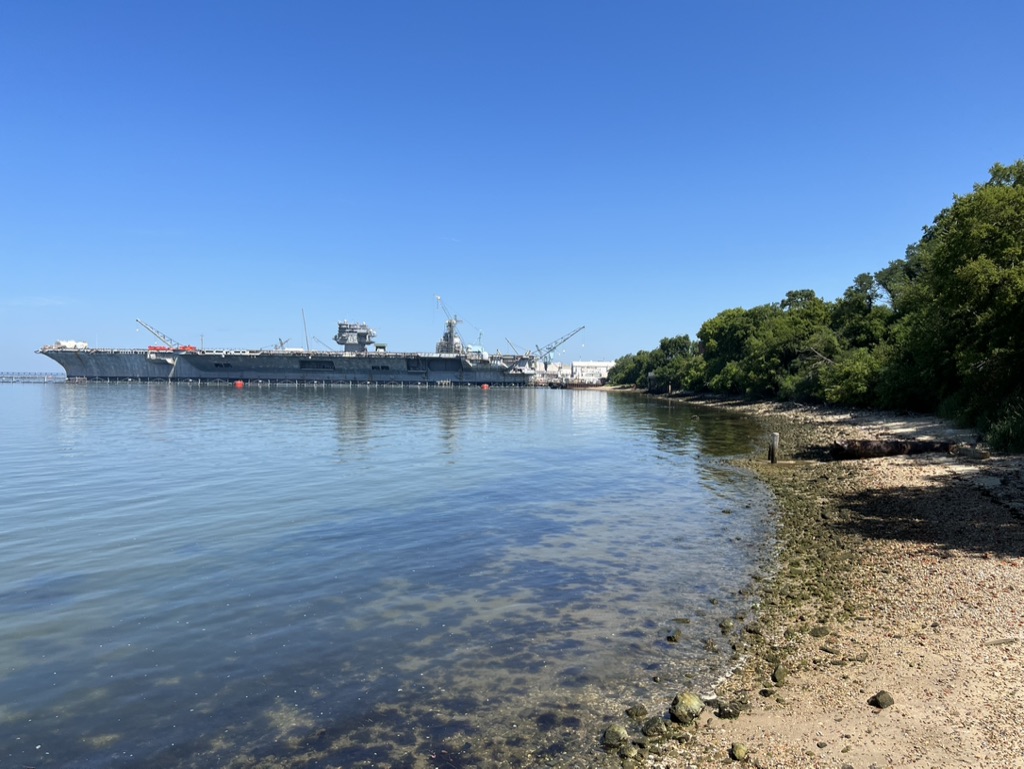


 John ultimately acquired 1490 acres, including 640 acres in Lower Norfolk County adjoining the Thorowgood estate in October 1641 after his marriage to Sarah Thorowgood. This land came to him for transporting 13 persons, which included 7 unnamed negroes. John and Daniel Gookin also patented land on the Rappahannock River along with Richard Bennett and other neighbors from the Nansemond region, although neither were resident there. [11]
John ultimately acquired 1490 acres, including 640 acres in Lower Norfolk County adjoining the Thorowgood estate in October 1641 after his marriage to Sarah Thorowgood. This land came to him for transporting 13 persons, which included 7 unnamed negroes. John and Daniel Gookin also patented land on the Rappahannock River along with Richard Bennett and other neighbors from the Nansemond region, although neither were resident there. [11] 
 While most government officials and Jamestown residents remained staunchly Anglican and tried to enforce adherence to the official religion, there were dissensions in Virginia as well as England in this pre-English Civil War era. The Munster area in Ireland that the Gookins came from was also known to have Puritan connections. Puritan influence in Virginia became particularly strong in Upper and Lower Norfolk and on the Eastern Shore. Richard Bennett, a friend and neighbor of the Gookins, went on to become the first Governor under the Puritan Commonwealth Era government.[14]
While most government officials and Jamestown residents remained staunchly Anglican and tried to enforce adherence to the official religion, there were dissensions in Virginia as well as England in this pre-English Civil War era. The Munster area in Ireland that the Gookins came from was also known to have Puritan connections. Puritan influence in Virginia became particularly strong in Upper and Lower Norfolk and on the Eastern Shore. Richard Bennett, a friend and neighbor of the Gookins, went on to become the first Governor under the Puritan Commonwealth Era government.[14]  Lacking a qualified minister, Daniel Gookin, Richard Bennett, and 69 other citizens from Upper Norfolk signed a letter in May 1642 addressed, not to William Laud, the Archbishop of Canterbury, but to Puritan “Pastors and Elders of Christ Church in New England.” They requested ministers be sent them from New England “that the word of God might be planted amongst us by Faithful Pastors and Teachers.” Unfortunately, only 10 of the 71 signers are now known. John Gookin was at that time living in Lower Norfolk, but still had land in Upper Norfolk, so may well have been one of the signatories. As early as 1633 when the Dutch visitor, Capt. DeVries, discussed English politics with Daniel Jr., Daniel leaned toward supporting Parliament, rather than the royalists. Daniel Jr. also became involved in intercolonial trade with the Puritans in New England even before he moved there. [15]
Lacking a qualified minister, Daniel Gookin, Richard Bennett, and 69 other citizens from Upper Norfolk signed a letter in May 1642 addressed, not to William Laud, the Archbishop of Canterbury, but to Puritan “Pastors and Elders of Christ Church in New England.” They requested ministers be sent them from New England “that the word of God might be planted amongst us by Faithful Pastors and Teachers.” Unfortunately, only 10 of the 71 signers are now known. John Gookin was at that time living in Lower Norfolk, but still had land in Upper Norfolk, so may well have been one of the signatories. As early as 1633 when the Dutch visitor, Capt. DeVries, discussed English politics with Daniel Jr., Daniel leaned toward supporting Parliament, rather than the royalists. Daniel Jr. also became involved in intercolonial trade with the Puritans in New England even before he moved there. [15] 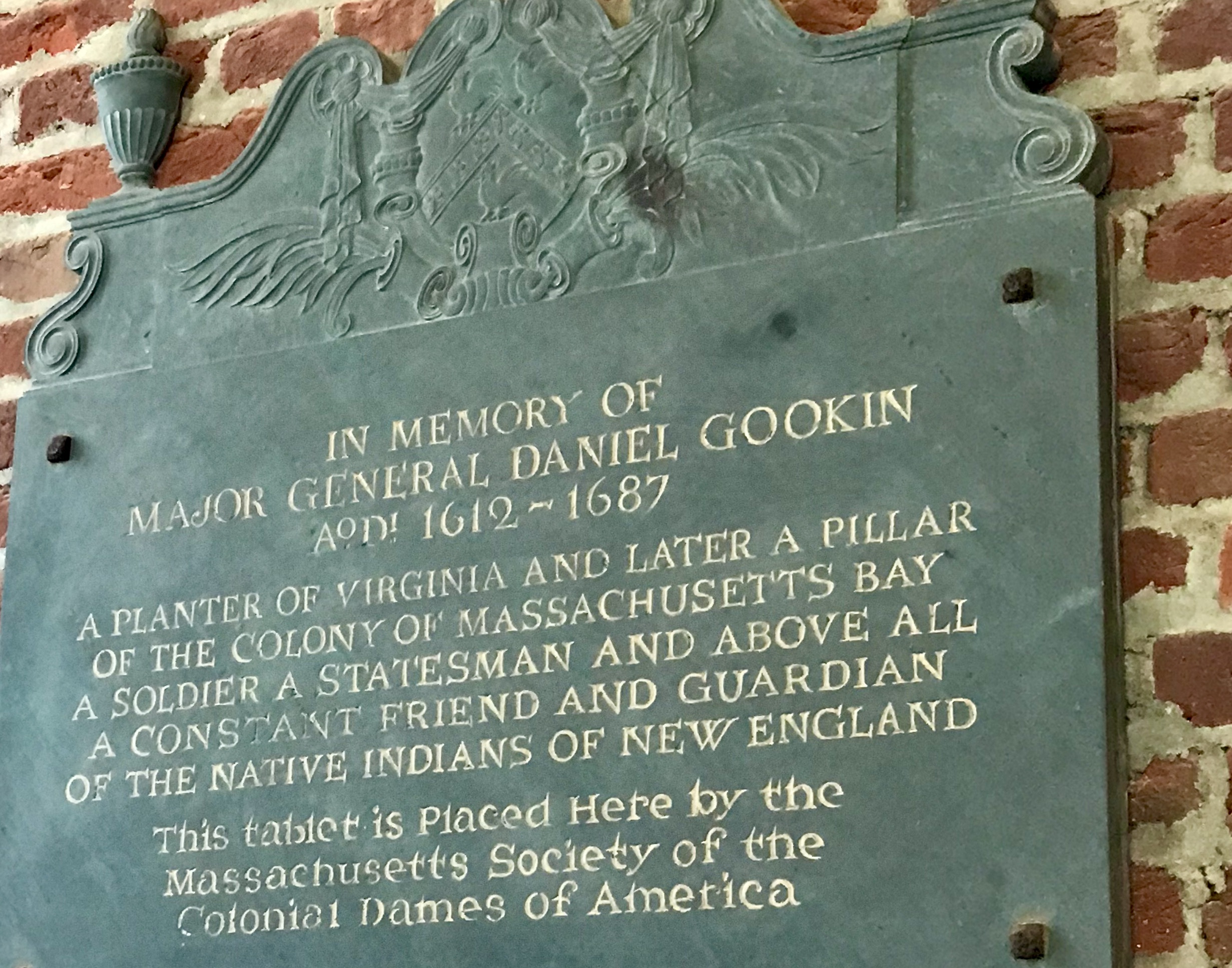

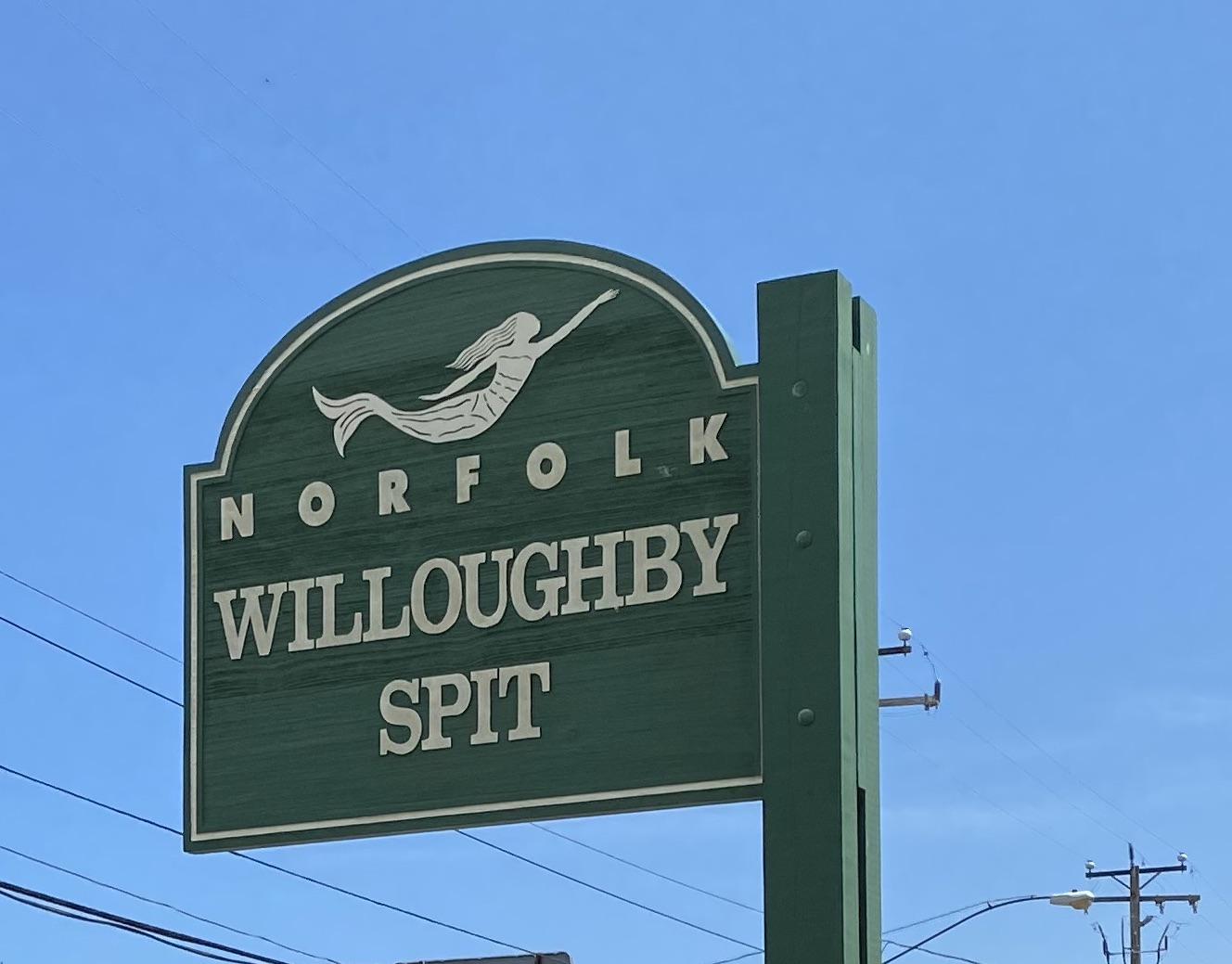 As would be expected under the legal concept of coverture, John Gookin took financial responsibility for the Thorowgood estate after the marriage. He pursued debt collection and represented the Thorowgood heirs in land matters in court. After his marriage, John stepped out of his older brother’s shadow and was quickly elevated to responsible positions and accorded increased status. Thomas Willoughby and John Gookin agreed to jointly build a store at Willoughby Point for the benefit of the community. John later was designated to provide a ferry at Lynnhaven on the lands of the Thorowgood heirs. “John Gookin’s Landing,” referred to in later deeds, was on Samuel Bennett’s Creek near the site called Ferry where the Old Donation Church was built. John was reported to represent Lower Norfolk County in the Assembly in 1640. [18]
As would be expected under the legal concept of coverture, John Gookin took financial responsibility for the Thorowgood estate after the marriage. He pursued debt collection and represented the Thorowgood heirs in land matters in court. After his marriage, John stepped out of his older brother’s shadow and was quickly elevated to responsible positions and accorded increased status. Thomas Willoughby and John Gookin agreed to jointly build a store at Willoughby Point for the benefit of the community. John later was designated to provide a ferry at Lynnhaven on the lands of the Thorowgood heirs. “John Gookin’s Landing,” referred to in later deeds, was on Samuel Bennett’s Creek near the site called Ferry where the Old Donation Church was built. John was reported to represent Lower Norfolk County in the Assembly in 1640. [18] 
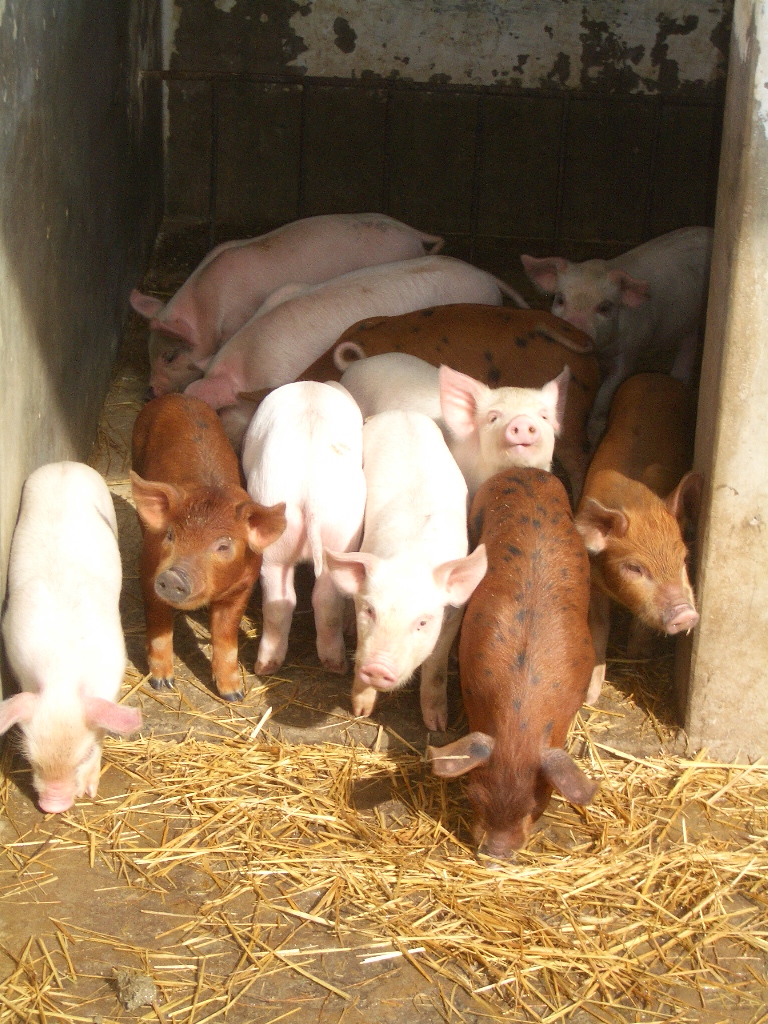 The first jury trial in Lower Norfolk County also concerned John Gookin. Whereas fellow justices generally had no qualms about passing judgment on cases involving their peers, they decided that using a jury of 12 men provided the “most equitable way” in this matter. As noted in a prior post, the hogs belonging to Capt. John Gookin escaped their pen and damaged the corn field of his neighbor Richard Foster. As Gookin had installed sturdy fencing to try to keep his hogs in and Foster had none to keep animals out, the jury found for Gookin. At that time, planters were expected to fence in their plants if they wanted to protect them from roaming animals. [20]
The first jury trial in Lower Norfolk County also concerned John Gookin. Whereas fellow justices generally had no qualms about passing judgment on cases involving their peers, they decided that using a jury of 12 men provided the “most equitable way” in this matter. As noted in a prior post, the hogs belonging to Capt. John Gookin escaped their pen and damaged the corn field of his neighbor Richard Foster. As Gookin had installed sturdy fencing to try to keep his hogs in and Foster had none to keep animals out, the jury found for Gookin. At that time, planters were expected to fence in their plants if they wanted to protect them from roaming animals. [20]  In the early years of the Jamestown Settlement, settlers had the expectation that the Indians would provide them corn, either by trade or force. The Nansemond tribe south of the James River under the paramount chiefdom of Powhatan first encountered Capt. John Smith and the English in 1608 when, under threat, they provided 400 baskets of corn. Although in the English perspective they parted good friends, hostilities increased as more demands were made for food and land. In 1609, Capt. John Martin was ordered to settle with his soldiers on Nansemond lands, but two of his advance soldiers went missing and were later found dead. After having been told that his men had been sacrificed and that “their brains had been cut and scraped out of their heads with mussel shells,” Capt. Martin ordered a complete destruction and desecration of the Nansemond’s sacred Dumpling Island. George Percy reported: [21]
In the early years of the Jamestown Settlement, settlers had the expectation that the Indians would provide them corn, either by trade or force. The Nansemond tribe south of the James River under the paramount chiefdom of Powhatan first encountered Capt. John Smith and the English in 1608 when, under threat, they provided 400 baskets of corn. Although in the English perspective they parted good friends, hostilities increased as more demands were made for food and land. In 1609, Capt. John Martin was ordered to settle with his soldiers on Nansemond lands, but two of his advance soldiers went missing and were later found dead. After having been told that his men had been sacrificed and that “their brains had been cut and scraped out of their heads with mussel shells,” Capt. Martin ordered a complete destruction and desecration of the Nansemond’s sacred Dumpling Island. George Percy reported: [21]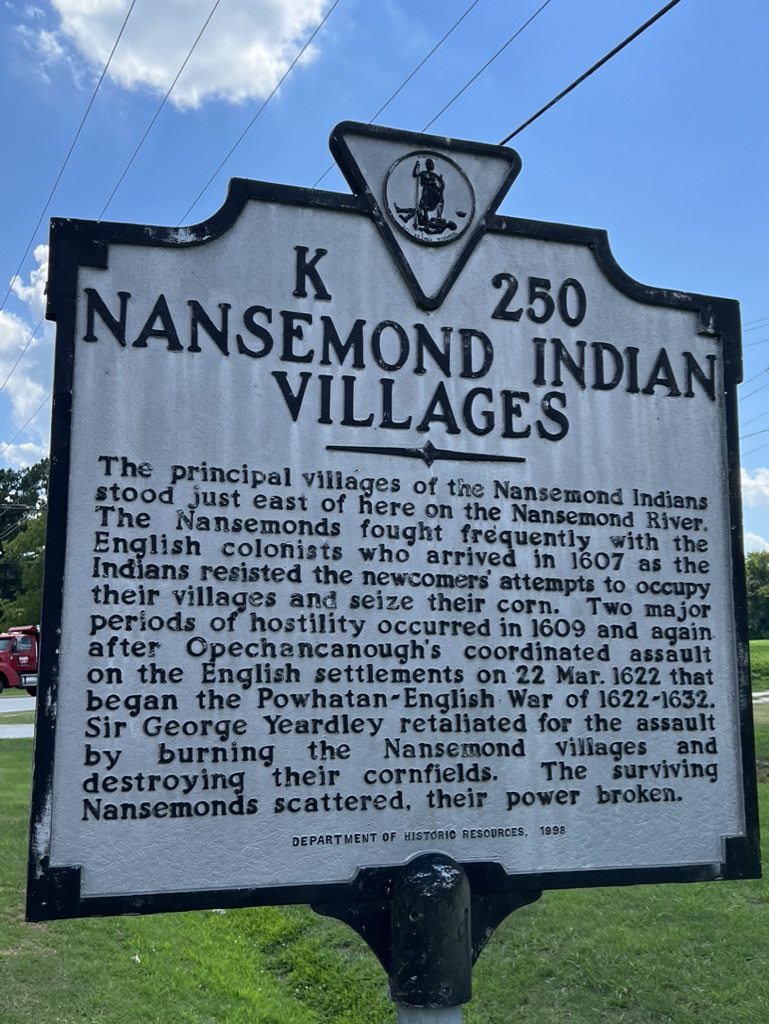 Thereafter, the English and Nansemonds were avowed enemies. The Nansemonds participated in the Powhatan uprising of 1622 and attacked Daniel Gookin Sr.’s Marie’s Mount and Edward Water’s Blount Point where they kidnapped Adam Thorowgood’s master and mistress. However, Edward Bennett’s plantation bore the brunt of that Nansemond attack with 53 dead. As noted earlier, the Nansemonds continued to periodically attack settlers at Marie’s Mount. The English sought revenge, but it was not until the late 1630s that the Nansemond threat was lessened, and they started to withdraw upriver or into the southern and northwestern branches of the Nansemond River.[22]
Thereafter, the English and Nansemonds were avowed enemies. The Nansemonds participated in the Powhatan uprising of 1622 and attacked Daniel Gookin Sr.’s Marie’s Mount and Edward Water’s Blount Point where they kidnapped Adam Thorowgood’s master and mistress. However, Edward Bennett’s plantation bore the brunt of that Nansemond attack with 53 dead. As noted earlier, the Nansemonds continued to periodically attack settlers at Marie’s Mount. The English sought revenge, but it was not until the late 1630s that the Nansemond threat was lessened, and they started to withdraw upriver or into the southern and northwestern branches of the Nansemond River.[22] 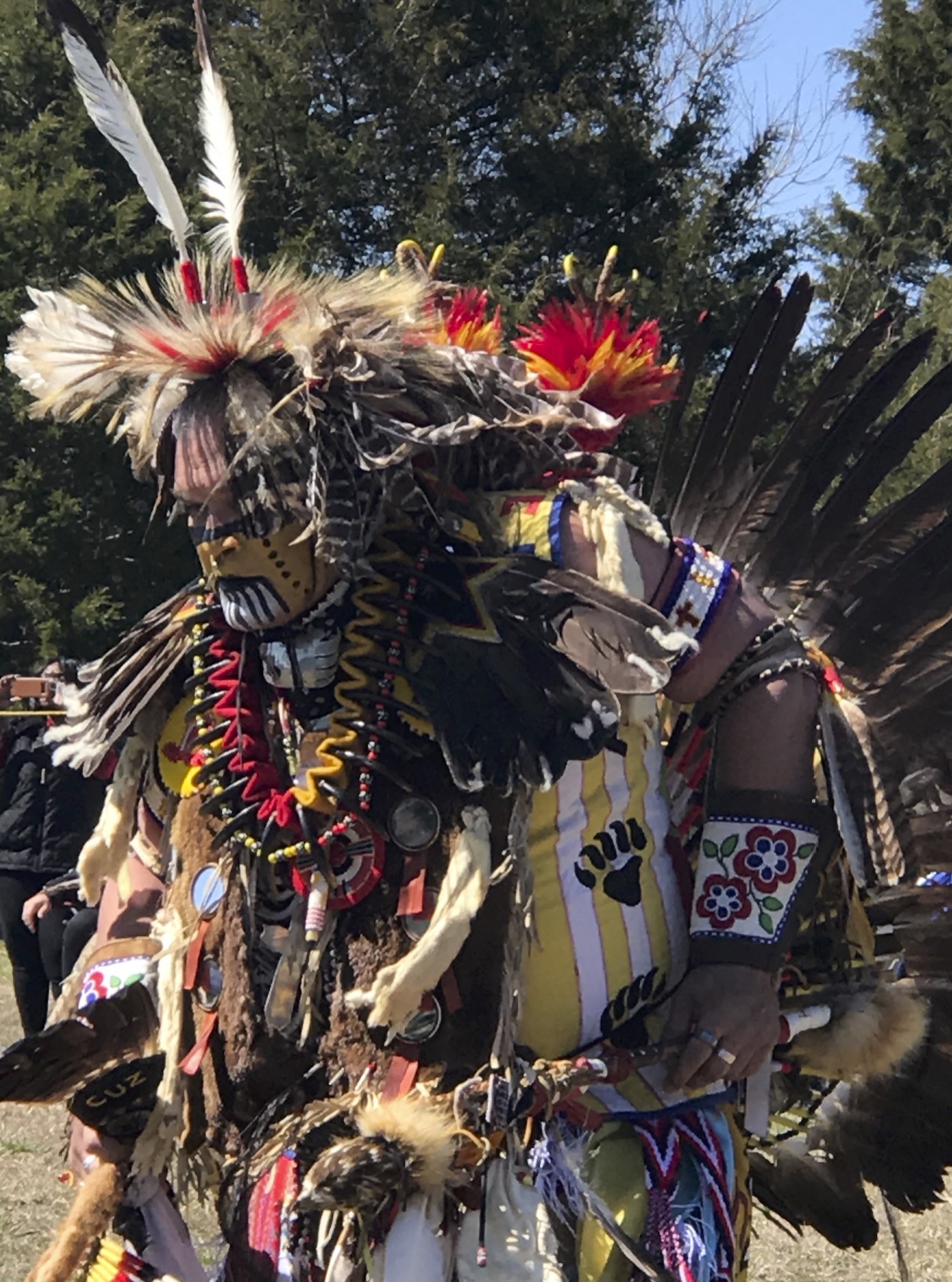
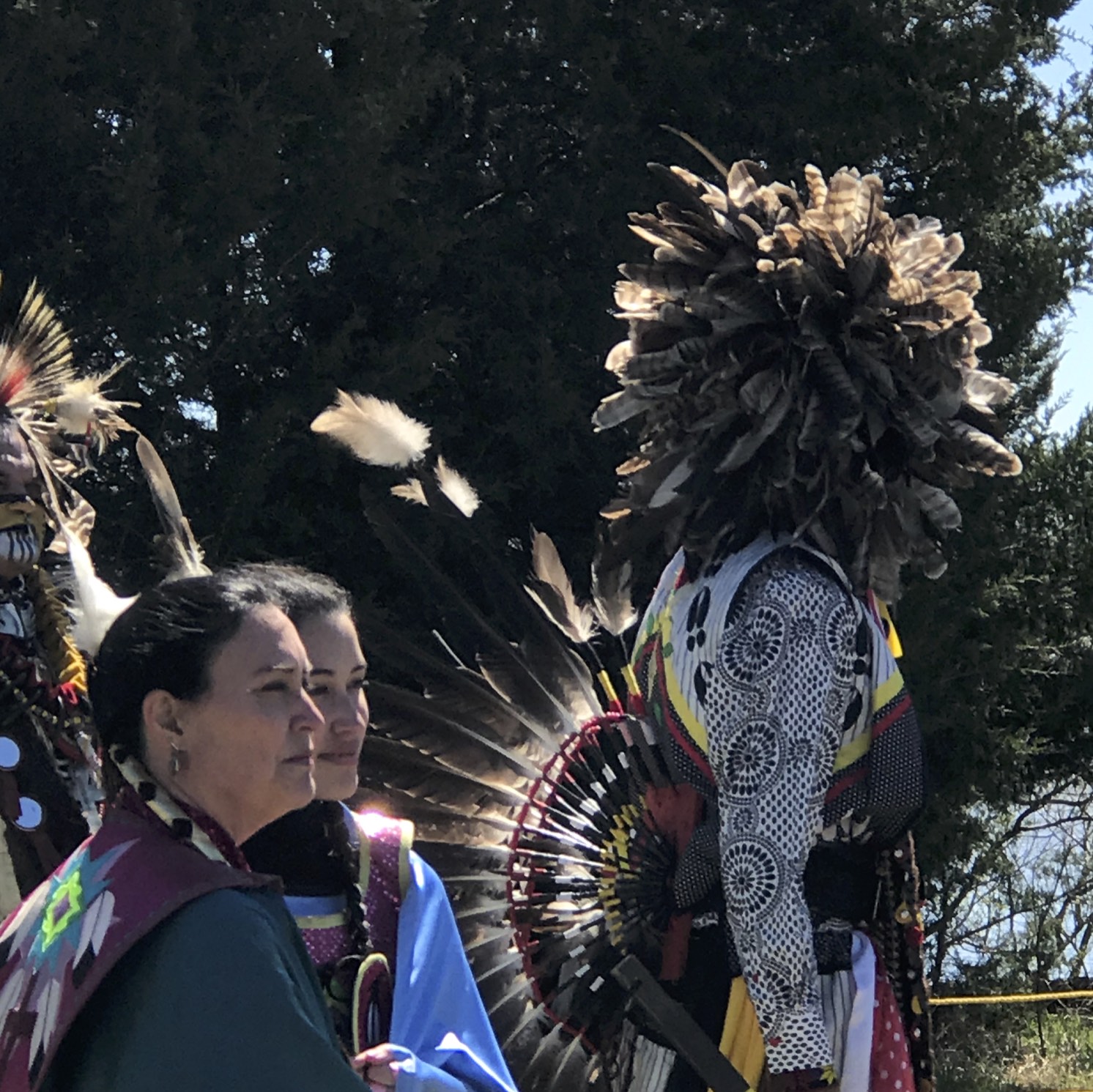
 John Gookin was dead by November 22, 1643 at the age of 30. Sarah Offley Thorowgood Gookin, 33, was once again a widow, now with 5 young children and responsibility for administering John’s estate as well as that of her former husband Adam Thorowgood. No record exists with Sarah’s thoughts about her husbands or her feelings of loss with their deaths. Nor do we know the cause of John’s death or the arrangements she made for his burial. However, he must have held a special place in her heart. At the time of her death 14 years later, she ordered two black marble tombstones from England, one being inscribed:
John Gookin was dead by November 22, 1643 at the age of 30. Sarah Offley Thorowgood Gookin, 33, was once again a widow, now with 5 young children and responsibility for administering John’s estate as well as that of her former husband Adam Thorowgood. No record exists with Sarah’s thoughts about her husbands or her feelings of loss with their deaths. Nor do we know the cause of John’s death or the arrangements she made for his burial. However, he must have held a special place in her heart. At the time of her death 14 years later, she ordered two black marble tombstones from England, one being inscribed:
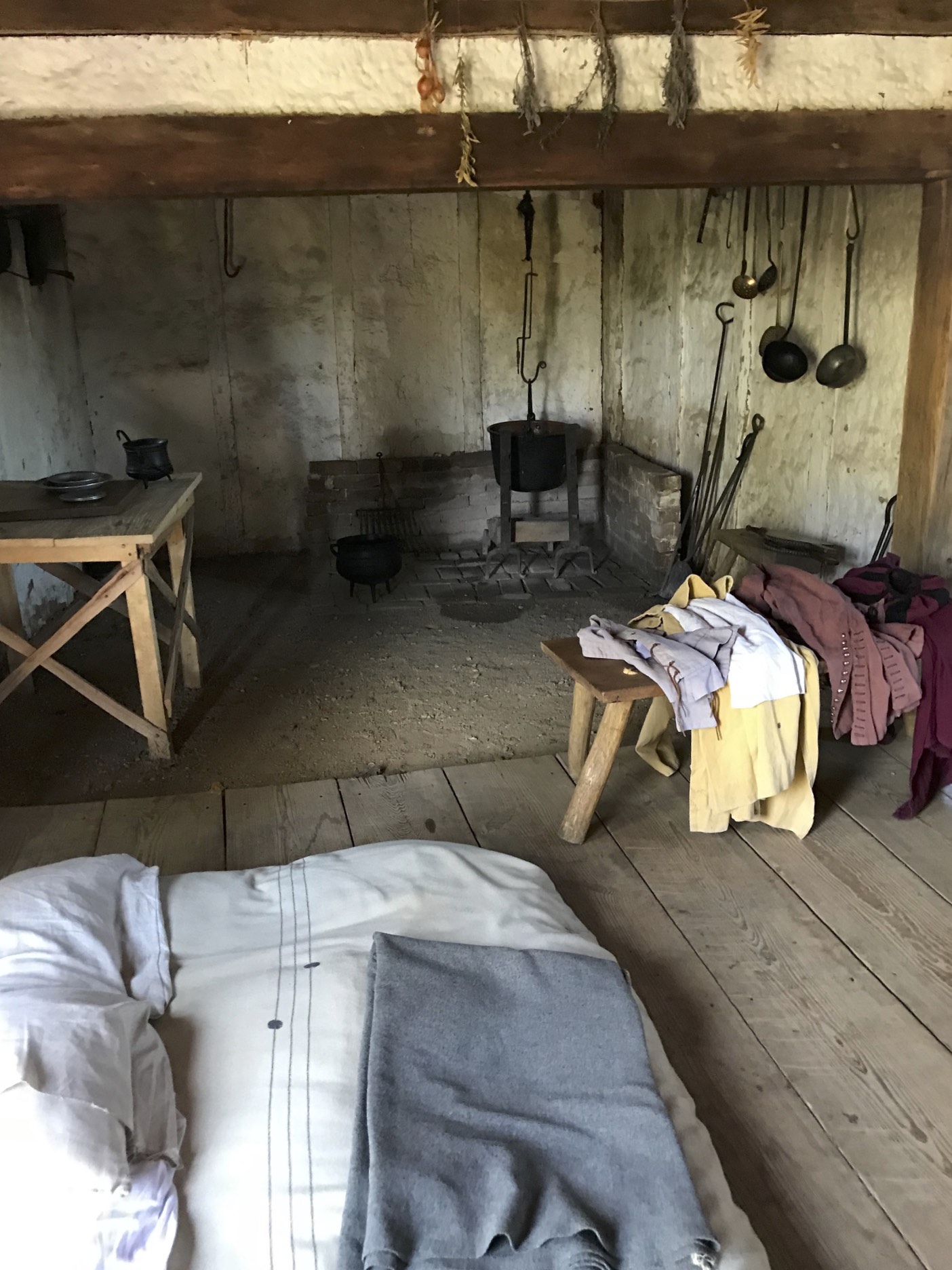
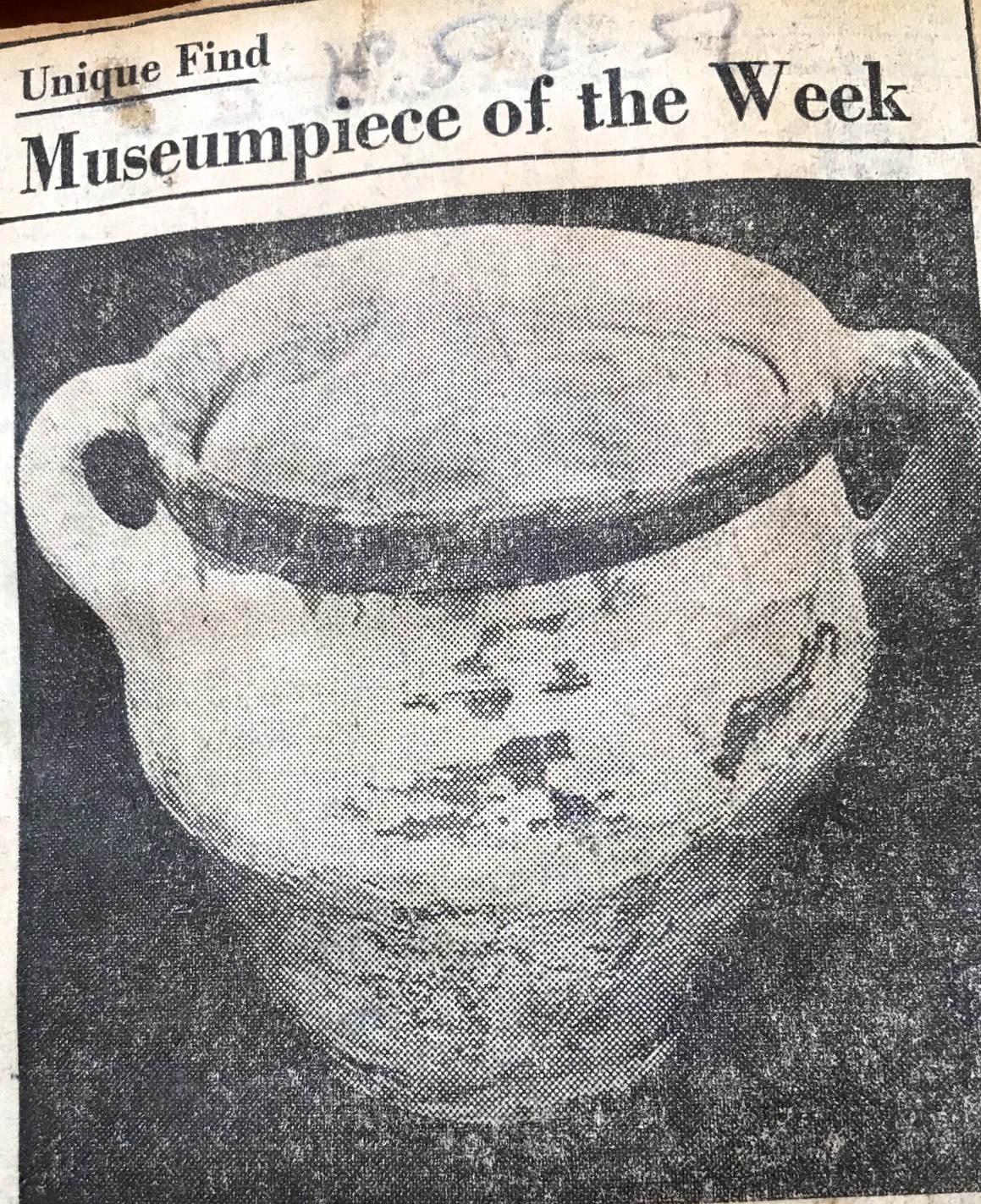 Further evidence of their wealthy style of living comes from the site itself. Following Floyd Painter’s excavation in 1955, a few of the noted artifacts became lost, although photos of them remain. A catalog of the over 5,000 remaining artifacts found by Painter and local homeowners was created by Merry Outlaw and Bly Bogley (Straube) in 1980 for The Virginia Research Center for Archaeology. In addition, limited test units were excavated by the James River Archaeological Institute (JRIA) under Nicholas Luccketti in 2005 where additional artifacts and features were found in neighborhood yards around the area of the now covered cellar. Whereas the inventory shows a portion of what Sarah and Adam shared before his death, the site artifacts extend the finds into the 1650s. [4]
Further evidence of their wealthy style of living comes from the site itself. Following Floyd Painter’s excavation in 1955, a few of the noted artifacts became lost, although photos of them remain. A catalog of the over 5,000 remaining artifacts found by Painter and local homeowners was created by Merry Outlaw and Bly Bogley (Straube) in 1980 for The Virginia Research Center for Archaeology. In addition, limited test units were excavated by the James River Archaeological Institute (JRIA) under Nicholas Luccketti in 2005 where additional artifacts and features were found in neighborhood yards around the area of the now covered cellar. Whereas the inventory shows a portion of what Sarah and Adam shared before his death, the site artifacts extend the finds into the 1650s. [4] 

